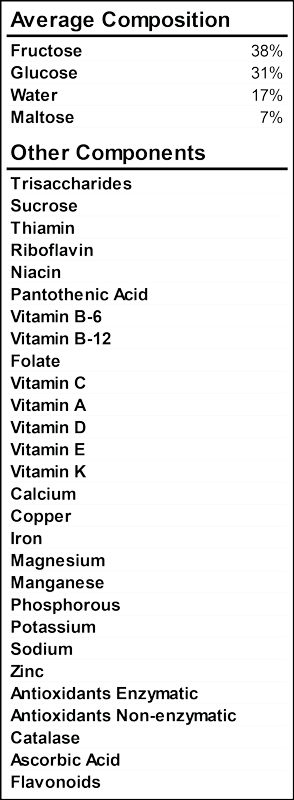

Many years ago, beekeepers crushed honeycomb to get liquid honey! That method of honey processing produces less honey for the beekeeper as it forces bees to spend time and resources building replacement comb rather than making more honey.
Mature honeybees collect nectar from plant blossoms. Nectar is 80 to 95 percent water and 5 to 20 percent sucrose (table sugar). As the bee transports the nectar back to the hive, a protein enzyme in her honey stomach, called invertase, breaks the sucrose down into the two simple sugars, fructose and glucose.
Young bees remove water from the sugar solution using two methods. They pass the nectar from bee to bee and ‘drink’ the water out of the nectar by absorbing it through their stomach wall. They also create heat and air flow in the hive by vibrating their wings and flight muscles, thus evaporating water out of the nectar which has been stored in open cells.
When most of the sucrose has been converted to fructose and glucose AND enough water has been dehydrated out of the mixture to bring it approximately 17.8% water content, we have a delicious sticky mixture, called honey!
After honey is made, bees cap it with beeswax to maintain the low moisture content.
Honeycomb
Untouched by human hands. Contains all the goodness that nature puts into the honey. Bit awkward to chew.
Raw Honey
Extracted and cleaned using a settling tank at room temperature. Contains virtually all the goodness that nature puts into the honey. Will granulate quickly and may separate in the jar with liquid fructose on top and granular glucose on the bottom.
Liquid Honey
Filtered with minimal heat. Extracted and cleaned using a 50-micron filter. Honey is heated to the same temperature inside a hive on a hot day. Contains a great deal of the goodness that nature put into the honey. Will granulate in two to six months, depending on the type of flowers the bees visited to gather the honey.
Creamed Honey
Creamed honey is made from pure liquid honey through a controlled crystallization process to produce very fine uniform crystals, thus resulting in a creamy smooth consistency. Creamed honey has nothing added and has the same nutritional value as its liquid counterpart.
Liquid Pasteurized Honey
Extracted and cleaned using flash heating to a high temperature, super filtered through a 1 to 5-micron filter, and quickly cooled. Loses much of the goodness that nature provided, but will last over 9 months on the store shelf without granulating.
Crystallization of honey is completely normal and does not damage the honey. In most cases the crystallization process can be reversed by gently warming the honey to “melt” the crystals.
How to De-Crystallize Honey?
Honey that has started to crystallize, characterized by glucose crystals forming on the bottom of the container, can be easily melted. Simply put the honey container (with the lid on) into a warm water bath on the stove at approximately 45 C for a couple hours, or as necessary. Stirring the honey, or turning the container upside down occasionally to break up the crystals, will speed the process.
There are hundreds of flowering plants in the world that produce nectar, thus providing the potential to have hundreds of types of honey. Wild flower honeys represent a blend of flowering plants, and varies in color and flavor depending on region and season.
The flavor, color, texture, and aroma of honey depends on which plants the bees gathered nectar from. Generally, a dark honey will have a higher nutritional content than a light honey.
The Urban Beekeeper relies on these plants & flowers, for its young ones:
Bloodwood
Ice-Cream-bean
Palm
Hackberry
Lemon
Mauby
Mangoes
Cashew
Avocado
Loquat
Health and Healing with Honey
The products produced by the honeybee are Royal Jelly, Pollen, Propolis, and Honey. These products may be taken separately in their native form or mixed into blends to provide the right balance in an easy to take mixture.
For thousands of years, the unique antimicrobial and antioxidant properties of honey have been valuable for healing cuts, scrapes, burns, and even open wounds.
Honey has been used in treating open wounds for centuries. Until the development of antibiotics in the mid-1900s, honey was the primary treatment for wounds on the battlefield. For the next 50 years, the use of honey in wound care, especially in western countries, lost favor. However, in the past 20 years there has been renewed interest in using honey, driven in large part by the concern of the rapid development of antibiotic resistant strains of bacteria.
There has been a large number of peer reviewed scientific studies that have shown the efficacy of using honey, particularly Manuka honey, in the treatment of severe chronic wounds such as diabetic foot ulcers. Honey can be used to treat open wounds, burns, and skin ulcers.
Results from studies have shown that honey used on open wounds has the following results:
- Inflammation, swelling and pain are quickly reduced
- Unpleasant odors cease
- Wound dressings can be changed painlessly with no damage to re-growing tissue
- Minimal scarring occurs
Honey has been shown to prevent the growth of wound bacteria and to protect the wound from getting infected. Honey also provides a moist, nutrient rich environment that actually assists the natural healing process of the body.
Anti-Microbial Properties of Honey
Unlike antibiotics that have a single mode of action against bacteria, honey has multiple modes of action that attack bacteria in different ways:
Osmotic Effect
Honey is over 80% sugar and leaves few water molecules available for micro-organisms.
Acidity
The pH level for honey is between 3.2 and 4.5, which is inhospitable for most wound bacteria that can tolerate a minimum pH level of approximately 4.0 to 4.5.
Hydrogen Peroxide
Honey contains glucose oxidase, an enzyme which facilitates a reaction that produces a slow release of hydrogen peroxide. The low levels of hydrogen peroxide produced are sufficient to kill bacteria without damaging tissue.
Phytochemical Factors
Some honey contains other plant chemicals with anti-microbial properties. These are not available in all types of honey. The best known, and most widely researched honey with phytochemical anti-microbial properties, is Manuka honey. Honey has been shown to be effective against species of bacteria most commonly involved in wound infection. This includes several studies showing honey being effective against “super bugs” such as Methicillin-Resistant-Staphylococcus Aureus (MSRA) and Vancomycin-Resistant-Enterococci (VRE).
Not All Honeys Are Equal!
All honey have anti-microbial properties. However, the anti-microbial activity can range up to 100 times, i.e. one honey may be up to 100 times more effective than another honey. Different honeys also have differing anti-microbial activities against various strains of wound bacteria.

Honey is a very robust food product, and if stored properly, will last years if not decades. In fact, honey has been found perfectly preserved in tombs of the Pharaohs in Egypt.
The quality of honey may be damaged by the following factors:
Excessive moisture
Ideally the moisture content of honey should be less than 17.8%. If the moisture content is too high, say greater than 20%, the honey may ferment due to yeasts in the honey. Since honey is hygroscopic, if it is not in a sealed container, it will attract moisture from the air.
Excessive heat
Honey loses many of its health benefits with the combination of heat and time. The following is a rule of thumb storage time vs temperature to retain most of its health benefits:
- 40 C for 30 days
- 30 C for 6 months
- 20 C for 4 years
- 10 C for 35 years
Prolonged exposure to sunlight
Honey loses many of its health benefits with prolonged exposure to sunlight.
Noxious elements in its environment
Honey is hygroscopic and takes on odors from its environment. It is also acidic, so it can dissolve metal if stored in metal containers.
Honey Storage Guidelines
Store honey in a sealed non-metallic container.
For normal use, store the container in a cupboard (away from direct sunlight) at room temperature (21 C).
For prolonged storage of honey (> 4 years), store at refrigerator temperature (4 C).
The bacterium, Clostridium botulinum is very common in nature and any raw food, including honey, may contain Clostridium botulinum spores.
A fully developed digestive system will protect a person against ingested C. botulinum. However, the digestive system of an infant under the age of 12 months is not fully developed, and thus cannot deal with many kinds of antigens, including C. botulinum. The toxins produced by C. botulinum are extremely dangerous and present a very serious condition for infants.
Honey is a raw food and is NOT recommended for infants less than 12 months of age
It is extremely rare to find C. botulinum in honey, but there has been a hand full of documented cases over the last 40 years. In these cases, it is thought that the bacteria came in contact with the honey somewhere during honey processing.
Due to honey’s bacteriostatic properties, bacteria, including C. botulinum, will not grow nor produce toxins in honey! C. botulinum spores are very resilient and can withstand harsh conditions, including the honey pasteurization process. If an infant were to ingest honey that was contaminated with C. botulinum spores, the honey would become diluted in the infant’s intestinal tract, and the spores would have suitable conditions to be activated, thus providing the conditions for botulism.
The honey pasteurization process does NOT destroy C. botulinum spores in honey!
